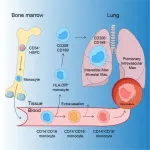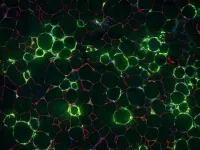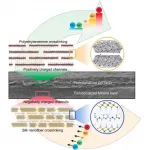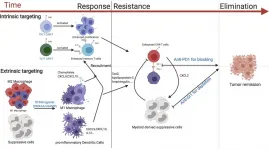(Press-News.org) In some cases, immune cells in the lungs can contribute to worsening a virus attack. In a new study, researchers at Karolinska Institutet in Sweden describe how different kinds of immune cells, called macrophages, develop in the lungs and which of them may be behind severe lung diseases. The study, which was published in Immunity, may contribute to future treatments for COVID-19, among other diseases.
The structure of the lungs exposes them to viruses and bacteria from both the air and the blood. Macrophages are immune cells that, among other things, protect the lungs from such attacks. But under certain conditions, lung macrophages can also contribute to severe lung diseases, such as chronic obstructive pulmonary disease (COPD) and COVID-19.
To date, research on the development of human lung macrophages has been limited.
Macrophages can have different origins and develop, among other things, from white blood cells, monocytes, that are divided into different genetically determined main types. In humans, two of these are "classical" CD14+ monocytes and "non-classical" CD16+ monocytes.
In a new study at Karolinska Institutet, researchers have used a model to study the development of lung macrophages directly in a living lung. This has been combined with a method to study gene activity in individual cells, RNA sequencing, and thereby discovered how blood monocytes become human lung macrophages.
"In our study, we show that classical monocytes migrate into airways and lung tissue and are converted into macrophages that protect the health and function of the lungs. We have also identified a special kind of monocyte, HLA-DRhi, which is an intermediate immune cell between a blood monocyte and an airway macrophage. These HLA-DRhi monocytes can leave the blood circulation and migrate into the lung tissue," says Tim Willinger, Associate Professor at the Department of Medicine, Huddinge, Karolinska Institutet, who led the study.
The non-classical monocytes, however, develop into macrophages in the many blood vessels of the lungs and do not migrate into the lung tissue.
"Certain macrophages in the lungs probably have a connection to a number of severe lung diseases. In respiratory infections, for example, monocytes in the lungs develop into macrophages, which combat viruses and bacteria. But a certain type of macrophage may also contribute to severe inflammation and infections," says the study's first author Elza Evren, a doctoral student in Tim Willinger's research team.
In an infection with the novel coronavirus, SARS-COV-2, which causes COVID-19, researchers believe that protective, anti-inflammatory macrophages are replaced by pro-inflammatory lung macrophages from blood monocytes.
"The existence of these blood monocyte-derived macrophages has been shown in other studies to correlate with how severely ill a person becomes in COVID-19 and how extensive the damage to the lungs is. Patients with severe COVID-19 also have fewer HLA-DRhi monocytes in their blood, probably because they move away from the blood into the lungs. Given their important role in rapid inflammatory responses, our results indicate that future treatments should focus on inflammatory macrophages and monocytes to reduce lung damage and mortality from severe COVID-19," says Tim Willinger.
INFORMATION:
The research is financed by the Swedish Research Council, Karolinska Institutet, Centre for Innovative Medicine (CIMED)/Region Stockholm, the Swedish Heart-Lung Foundation, and the Swedish Cancer Foundation. There are no reported conflicts of interest.
Publication: "Distinct developmental pathways from blood monocytes generate human lung macrophage diversity". Elza Evren, Emma Ringqvist, Kumar Parijat Tripathi, Natalie Sleiers, Ines Co Rives, Arlisa Alisjahbana, Yu Gao, Dhifaf Sarhan, Tor Halle, Chiara Sorini, Rico Lepzien, Nicole Marquardt, Jakob Michaelsson, Anna Smed-Sorensen, Johan Botling, Mikael C. I. Karlsson, Eduardo J. Villablanca, Tim Willinger. Immunity, online 30 December 2020, doi: 10.1016/j.immuni.2020.12.003.
East Hanover, NJ. December 30, 2020. A team of rehabilitation researchers has studied processing speed deficits in individuals with spinal cord injury (SCI), comparing their brain activation patterns with those of healthy age-matched controls, and older healthy individuals. They found that the SCI group and older controls had similar activation patterns, but the SCI group differed significantly from their age-matched controls.
The article, "The neural mechanisms underlying processing speed deficits in individuals who have sustained a spinal cord injury: A pilot study" (doi: 10.1007/s10548-020-00798-x) was ...
BOSTON -- A peer-reviewed paper published in The New England Journal of Medicine provides data from the much-anticipated COVE study, which evaluated mRNA-1273, a vaccine candidate against COVID-19 manufactured by Moderna, Inc. Results from the primary analysis of the study, which will continue for two years, provide evidence that the vaccine can prevent symptomatic infection. Among the more than 30,000 participants randomized to receive the vaccine or a placebo, 11 of those in the vaccine group developed symptomatic COVID-19 compared to 185 participants who received the placebo, demonstrating 94.1 percent efficacy in preventing symptomatic COVID-19. Cases ...
December 30, 2020 - As the COVID-19 pandemic emerged, trauma centers faced unprecedented obstacles to providing care for injured patients. A look at steps taken by trauma centers in response to COVID-19 is provided by a survey in the January/February Journal for Healthcare Quality (JHQ), the peer-reviewed journal of the National Association for Healthcare Quality (NAHQ). The journal is published in the Lippincott portfolio by Wolters Kluwer.
Trauma centers introduced new processes to optimize use of personal protective equipment (PPE), ICU beds, ventilators, and other limited resources, according to the report by David Bar-Or, MD, of ION Research, Englewood, Colo., ...
WHAT:
The investigational vaccine known as mRNA-1273 was 94.1% efficacious in preventing symptomatic coronavirus disease 2019 (COVID-19), according to preliminary results from a Phase 3 clinical trial reported in the New England Journal of Medicine. The vaccine also demonstrated efficacy in preventing severe COVID-19. Investigators identified no safety concerns and no evidence of vaccine-associated enhanced respiratory disease (VAERD).
The vaccine was co-developed by Moderna, Inc., a biotechnology company based in Cambridge, Massachusetts, and the National Institute of Allergy and Infectious Diseases (NIAID), part of the National Institutes ...
"Today's computer applications generate a large amount of data that needs to be processed by machine learning algorithms," says Yeseong Kim of Daegu Gyeongbuk Institute of Science and Technology (DGIST), who led the effort.
Powerful 'unsupervised' machine learning involves training an algorithm to recognize patterns in large datasets without providing labelled examples for comparison. One popular approach is a clustering algorithm, which groups similar data into different classes. These algorithms are used for a wide variety of data analyses, such as identifying fake news on social media, filtering spam in our e-mails, and detecting ...
DALLAS - Dec. 30, 2020 - When fat cells in the body are stuffed with excess fat, the surrounding tissue becomes inflamed. That chronic, low-level inflammation is one of the driving factors behind many of the diseases associated with obesity. Now, UT Southwestern scientists have discovered a type of cell responsible, at least in mice, for triggering this inflammation in fat tissue. Their findings, published in Nature Metabolism, could eventually lead to new ways to treat obesity.
"The inflammation of fat cells in obese individuals is linked to many of the ...
Lithium is an energy-critical element that is considered to be a geopolitically significant resource. However, the supply of lithium may not be enough to meet continuously increasing demand. As a result, scientists are looking for new ways to extract lithium ions.
Ion selective membranes have already been used extensively for water treatment and ion sieving in electrodialysis technology. However, conventional membranes exhibit low and useless Li+ selectivity, making them insufficient for meeting industry requirements.
Chinese scientists have recently made progress in the preparation and application of a bioinspired ...
Arctic sea ice has been rapidly declining in recent decades, and changes in arctic sea ice can have a significant impact on global weather and climate through interactions with the atmosphere and oceans. In addition, the Arctic shipping routes are a shortcut to connect the major countries in the Northern Hemisphere. The Arctic region is also rich in natural resources and biological resources. Simulation of the Arctic sea ice could provide valuable information for Arctic shipping as well as climate studies, and it is therefore urgent to evaluate the ability to simulate Arctic sea ice and diagnose the sources of simulation errors.
To address the issue of error source identification, ...
Experts in optical physics have developed a new way to see inside living cells in greater detail using existing microscopy technology and without needing to add stains or fluorescent dyes.
Since individual cells are almost translucent, microscope cameras must detect extremely subtle differences in the light passing through parts of the cell. Those differences are known as the phase of the light. Camera image sensors are limited by what amount of light phase difference they can detect, referred to as dynamic range.
"To see greater detail using the same image sensor, we must expand the dynamic range so that we can ...
Activating an immune signaling pathway best known for fighting viral and bacterial infections can boost the ability of genetically engineered T cells to eradicate breast cancer in mice, according to a new study by researchers at the University of North Carolina. The study, to be published December 31 in the Journal of Experimental Medicine (JEM), suggests that CAR T cells, which are already used to treat certain blood cancers in humans, may also be successful against solid tumors if combined with other immunotherapeutic approaches.
Chimeric antigen receptor (CAR) T cells are a type of white blood cell that have been genetically engineered to recognize ...








